People - Cromwell Dixon
A Boy and His Plane...
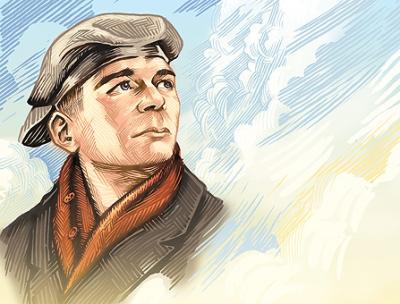
Scarcely older than the age of flight itself, 19-year-old pilot Cromwell Dixon was a national sensation. Sponsored by the Curtiss Aeorplane Company, Dixon spent the summer of 1911 entertaining and astounding audiences across the country with his flying skills in a plane called the Little Hummingbird.
Invited to perform at the Montana State Fair in Helena, the nation’s youngest licensed pilot took on the challenge that had eluded top aviators for years: to be the first cross the Continental Divide by air.
After scouting rugged mountain ranges, the tiny town of Blossburg on the Mullan Pass was selected as the landing area. Dixon’s crew, along with many other observers, went and set up a bonfire to help guide the plane. On the afternoon of September 30, he took off from the cheering crowds at the Helena Fairgrounds determined to achieve a goal that some thought was impossible...
The Little Hummingbird left Helena shortly after 2 p.m. The wings dipped side to side as Cromwell searched for balance in the steady winds pushing the machine. Once he found his balance, the point of equilibrium, he stabilized the machine and circled the track before he veered west.
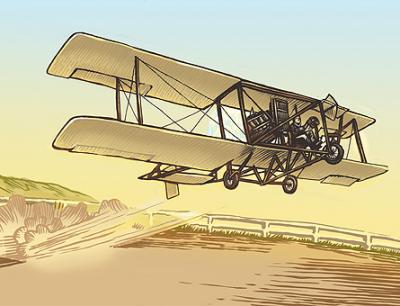
As he flew, Cromwell gained altitude, climbing 1,000 feet, then 2,000 feet. Ten minutes passed and still the aeroplane hung above the valley, easily seen as it circled up, climbing higher and higher. When he was soaring 3,000 feet above the valley, he came in line with Mullan Pass and the Continental Divide.
Governor Norris watched as well, dazzled by the display. while mulling over his speech in the event that Cromwell was successful in his crossing. Earlier, the governor had given Cromwell a letter to deliver to the folks in Blossburg. As far as anyone knew, the governor mused, Cromwell was carrying the first piece of mail ever delivered by an aeroplane in Montana.
But Cromwell had to make it to Blossburg before he could deliver it. The engine purred. No sign of trouble. And there was the smoke curling from the mountain, dead ahead! But in the wind, the smoke might as well have been a million miles away, a mirage or an apparition. The wind cut fiercely across the ridge.
Cromwell saw the effect it had on the smoke and braced for turbulence, gripping the wheel tighter. The machine was so light the slightest loss of balance could upset the craft and bring the flight to a sudden and tragic end.
Cromwell thought of a previous aviator losing altitude over the mountains. He thought of the peculiar suction that had pulled him to the ground. The atmospheric conditions had the final say with that pilot, but Cromwell didn’t plan to let his flight end without a fight. He’d go down kicking—if he went down at all.
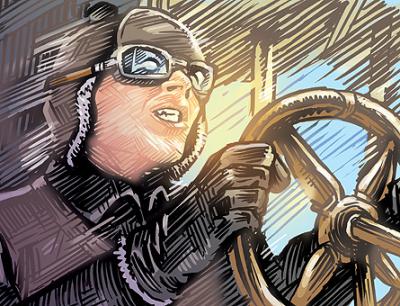
Easy as she flies, he told himself. Maintain altitude. Ride her through. The treetops drew closer to the wheels as he soared over the gulches and knolls. Gaining more altitude wasn’t an option. As hard as he tried—giving it more throttle, more speed—the aeroplane wouldn’t climb any higher.
Hold the course, he thought. He gave the machine all it had, the engine roaring, the wings rocking and dipping.
Crosscurrents and eddies battered the machine. Damn, he thought. Choppy mountain air! He responded to each slap of wind, holding his ground against the currents that swirled up on invisible streams, or pressed down from above. The propeller whined with a feverish pitch, the blades slicing the air.
He was almost there. He could see the pass, the bonfire, even smell the smoke. He could see the men remove their caps, waving him in.
He aligned the aeroplane with the meadow below. How’s this going to end? he wondered, his body erect. The field was approaching fast, the men growing larger, the smoke growing darker.
Cromwell wiped his goggles. The ground was rising fast. Flat terrain was in short supply. The entire field sloped away, rolling softly down the mountain toward the valley below. Tall pine trees surrounded the clearing and rocks and holes pocketed the meadow, a gopher’s lair. The key was to come in slow.
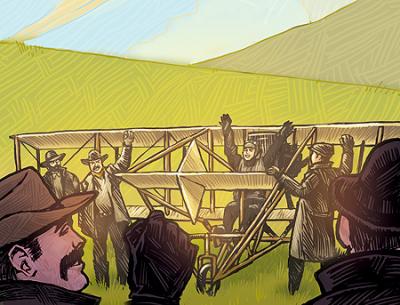
Focus, he told himself. Never mind the fuel. He rolled his shoulders to ease the tension as the engine roared behind him.
This is the moment.
The guide fire continued to burn, the embers blasted by the wind. Cromwell tensed for the impact. Set her down, he told himself. Set her down now! The machine dropped, leveled, then dropped again. The ground raced up toward him. Three…two…. He held his breath. Three…Two…One…. He felt the bump of the wheels on the ground. They rumbled over the meadow, the machine jarring him in his seat. When he rolled to a stop, he grinned, pulled the pocket watch from his jacket, and checked the time. It was 2:34 p.m.
There it is, he sighed, numbed and overjoyed. You’re the first pilot to fly an aeroplane over the crest of the Rocky Mountains.
Cromwell leaned back into his seat. He released a deep breath and shivered under his leather coat. It was cold, and getting colder. His lips were tinged a chilly blue. Even so, a slow grin spread across his face when the throng of people raced over to greet him.
“Tell the folks in Helena I arrived!” Cromwell shouted, jumping down from the machine. “Tell them I’ll start back in a few minutes. Tell them I’ll see them before 4 o’clock.”
Cromwell shook hands with those around him, beaming under the clap of their hearty congratulations. “That reminds me,” he said, pulling the governor’s letter from his pocket. “This belongs to you.”
One of the men opened the letter. The man grinned as he read the governor’s name.
At 3:16 p.m., the “man-built bird” left the meadow and faded from view. The aeroplane vanished as quickly as it had arrived, fluttering away on wings of wood and sailing toward the valley below. A jaunty little machine dreamed up by men, a marvelous sight to behold.
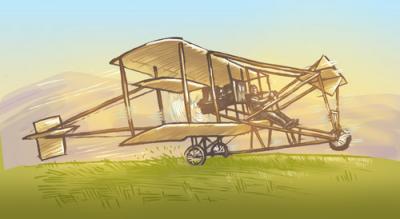
“The car with the [mechanicians], helpers, and press representatives left immediately after but were, of course, beaten to Helena by the aeroplane,” wrote a reporter with The Helena Independent. “Minutes seemed hours to the big crowd in the grandstands while they continued to watch for the aviator, and when he was finally sighted, a mighty cheer went up. Gradually the little speck, which had come over the mountain, assumed larger proportions and soon the outline of the machine was plainly discernable.”
As news of the pilot’s approach spread in the stands, thousands of independent conversations converged into a rambling murmur. Cromwell’s machine grew larger in the sky. He sat bravely behind the wheel, stiff as a statue. Gasoline fed the engine but adrenaline fed his nerves. Instead of landing, he flew across the crowd one last time, the engine roaring. Twice he circled the track until, his journey over, he alighted in the infield.
“A greater ovation than ever before given anyone at the fairgrounds was accorded Dixon when he mounted the platform,” The Helena Independent reported. “Governor Norris declared that Dixon was without a peer in the realm of air.
“I knew that boy would make good,” Cromwell’s mechanic said, wearing a crooked smile. “A poor machine and a good aviator would have been unable to have made the trip, and a good machine and a poor aviator would have been equally unsuccessful. Great credit is due Dixon for his achievement, which is without parallel in the history of aviation.”
The euphoria around Cromwell Dixon’s accomplishment was short-lived. Two days later, at an air show in Spokane, Washington, a blast of wind threw the Little Hummingbird to the ground, killing the young pilot. The tragic news raced to Helena, and broke the hearts of a town that had fallen in love with their adopted hero.
Cromwell Dixon’s legacy as a young inventor and brave aviator has won over a new generation of admirers, securing his place in history.
Cromwell Dixon: A Boy and His Plane is published by Farcountry Press. Look for it in local bookstores or visit www.farcountrypress.com for more information.
Leave a Comment Here
Leave a Comment Here